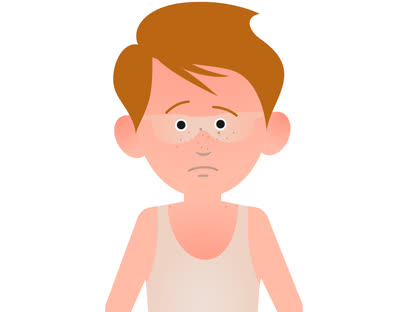Top of the pageCheck Your Symptoms
Sunburn
Overview
Being out in the sun can be good for you. Sunlight can brighten your mood and help you feel healthier. But getting too much of the ultraviolet (UV) rays from sunlight or from indoor tanning can harm your skin. It can cause problems right away as well as problems that may develop years later.
A sunburn is skin damage from the sun's ultraviolet A and ultraviolet B (UVA and UVB) rays. Most sunburns cause mild pain and redness but affect only the outer layer of skin (first-degree burn, Opens dialog). The red skin might hurt when you touch it. These sunburns are mild. They can usually be treated at home.
Skin that is red and painful and that swells up and blisters may mean that deep skin layers and nerve endings have been damaged (second-degree burn, Opens dialog). This type of sunburn is usually more painful and takes longer to heal.
Other problems that can occur along with sunburn include:
- Heatstroke, Opens dialog or other heat-related illnesses from too much sun exposure.
- Allergic reactions to sun exposure, sunscreen products, or medicines, such as antibiotics, some acne medicines, and some diabetes medicines.
- Vision problems, such as burning pain, decreased vision, or partial or complete vision loss.
Long-term problems include:
- An increased chance of having skin cancer.
- Having more cold sores, Opens dialog.
- More risk of problems related to a health condition, such as lupus, Opens dialog.
- Cataracts, Opens dialog from not protecting your eyes from direct or indirect sunlight over many years. Cataracts are one of the leading causes of blindness.
- Skin changes, such as premature wrinkling or brown spots.
Your skin type affects how easily you get sunburned. People with white or freckled skin, blond or red hair, and blue eyes usually sunburn easily.
People with darker skin don't sunburn as easily. But they can still get skin cancer. So it's important to use sun protection, no matter what your skin color is.
Your age also affects how your skin reacts to the sun. Children's skin is more sensitive to sunlight.
You may get a more severe sunburn depending on:
- The time of day. You are more likely to get a sunburn between 10 in the morning and 4 in the afternoon, when the sun's rays are the strongest. You might think the chance of getting a sunburn on cloudy days is less, but the sun's damaging UV light can pass through clouds.
- Whether you are near reflective surfaces, such as water, white sand, concrete, snow, or ice. All of these reflect the sun's rays and can increase your risk of getting a sunburn.
- The season of the year. The position of the sun on summer days can cause a more severe sunburn.
- Altitude. It's easy to get sunburned at higher altitudes. That's because there's less of the earth's atmosphere to block the sunlight. UV exposure increases in elevation.
- How close you are to the equator (latitude). The closer you are to the equator, the more direct sunlight passes through the atmosphere. For example, the southern United States gets more sunlight than the northern United States.
- The UV index, Opens dialog of the day, which shows the risk of getting a sunburn that day.
Preventive measures and home treatment are usually all that's needed to prevent or treat a sunburn.
- Protect your skin from the sun.
- Don't stay in the sun too long.
- Use sunscreen, and wear clothing that covers your skin.
If you have any health risks such as having diabetes or cancer, or if you take medicines that may increase the seriousness of sun exposure, you should avoid being in the sun from 10 in the morning to 4 in the afternoon.
Related Videos
The medical assessment of symptoms is based on the body parts you have.
- If you are transgender or nonbinary, choose the sex that matches the body parts (such as ovaries, testes, prostate, breasts, penis, or vagina) you now have in the area where you are having symptoms.
- If your symptoms aren’t related to those organs, you can choose the gender you identify with.
- If you have some organs of both sexes, you may need to go through this triage tool twice (once as "male" and once as "female"). This will make sure that the tool asks the right questions for you.
Many things can affect how your body responds to a symptom and what kind of care you may need. These include:
- Your age. Babies and older adults tend to get sicker quicker.
- Your overall health. If you have a condition such as diabetes, HIV, cancer, or heart disease, you may need to pay closer attention to certain symptoms and seek care sooner.
- Medicines you take. Certain medicines, such as blood thinners (anticoagulants), medicines that suppress the immune system like steroids or chemotherapy, herbal remedies, or supplements can cause symptoms or make them worse.
- Recent health events, such as surgery or injury. These kinds of events can cause symptoms afterwards or make them more serious.
- Your health habits and lifestyle, such as eating and exercise habits, smoking, alcohol or drug use, sexual history, and travel.
Try Home Treatment
You have answered all the questions. Based on your answers, you may be able to take care of this problem at home.
- Try home treatment to relieve the symptoms.
- Call your doctor if symptoms get worse or you have any concerns (for example, if symptoms are not getting better as you would expect). You may need care sooner.
Symptoms of infection may include:
- Increased pain, swelling, warmth, or redness in or around the area.
- Red streaks leading from the area.
- Pus draining from the area.
- A fever.
You can get dehydrated when you lose a lot of fluids because of problems like vomiting or fever.
Symptoms of dehydration can range from mild to severe. For example:
- You may feel tired and edgy (mild dehydration), or you may feel weak, not alert, and not able to think clearly (severe dehydration).
- You may pass less urine than usual (mild dehydration), or you may not be passing urine at all (severe dehydration).
Severe dehydration means:
- Your mouth and eyes may be extremely dry.
- You may pass little or no urine for 12 or more hours.
- You may not feel alert or be able to think clearly.
- You may be too weak or dizzy to stand.
- You may pass out.
Moderate dehydration means:
- You may be a lot more thirsty than usual.
- Your mouth and eyes may be drier than usual.
- You may pass little or no urine for 8 or more hours.
- You may feel dizzy when you stand or sit up.
Mild dehydration means:
- You may be more thirsty than usual.
- You may pass less urine than usual.
Severe dehydration means:
- The baby may be very sleepy and hard to wake up.
- The baby may have a very dry mouth and very dry eyes (no tears).
- The baby may have no wet diapers in 12 or more hours.
Moderate dehydration means:
- The baby may have no wet diapers in 6 hours.
- The baby may have a dry mouth and dry eyes (fewer tears than usual).
Mild dehydration means:
- The baby may pass a little less urine than usual.
If you're not sure if a fever is high, moderate, or mild, think about these issues:
With a high fever:
- You feel very hot.
- It is likely one of the highest fevers you've ever had. High fevers are not that common, especially in adults.
With a moderate fever:
- You feel warm or hot.
- You know you have a fever.
With a mild fever:
- You may feel a little warm.
- You think you might have a fever, but you're not sure.
Pain in adults and older children
- Severe pain (8 to 10): The pain is so bad that you can't stand it for more than a few hours, can't sleep, and can't do anything else except focus on the pain.
- Moderate pain (5 to 7): The pain is bad enough to disrupt your normal activities and your sleep, but you can tolerate it for hours or days. Moderate can also mean pain that comes and goes even if it's severe when it's there.
- Mild pain (1 to 4): You notice the pain, but it is not bad enough to disrupt your sleep or activities.
Pain in children under 3 years
It can be hard to tell how much pain a baby or toddler is in.
- Severe pain (8 to 10): The pain is so bad that the baby cannot sleep, cannot get comfortable, and cries constantly no matter what you do. The baby may kick, make fists, or grimace.
- Moderate pain (5 to 7): The baby is very fussy, clings to you a lot, and may have trouble sleeping but responds when you try to comfort him or her.
- Mild pain (1 to 4): The baby is a little fussy and clings to you a little but responds when you try to comfort him or her.
Certain health conditions and medicines weaken the immune system's ability to fight off infection and illness. Some examples in adults are:
- Diseases such as diabetes, cancer, heart disease, and HIV/AIDS.
- Long-term alcohol and drug problems.
- Steroid medicines, which may be used to treat a variety of conditions.
- Chemotherapy and radiation therapy for cancer.
- Other medicines used to treat autoimmune disease.
- Medicines taken after organ transplant.
- Not having a spleen.
Many prescription and nonprescription medicines can cause the skin to sunburn more easily. A few common examples are:
- Some antibiotics.
- Aspirin, ibuprofen (such as Advil or Motrin), and naproxen (such as Aleve).
- Skin products that contain vitamin A or alpha hydroxy acids (AHA).
- Some acne medicines.
- Some diabetes medicines that you take by mouth.
Symptoms of an allergic reaction may include:
- A rash, or raised, red areas called hives.
- Itching.
- Swelling.
- Trouble breathing.
- Mild belly pain or nausea.
Symptoms of heatstroke may include:
- Feeling or acting very confused, restless, or anxious.
- Trouble breathing.
- Sweating heavily, or not sweating at all (sweating may have stopped).
- Skin that is red, hot, and dry, even in the armpits.
- Passing out.
- Seizure.
- Nausea and vomiting.
Heatstroke occurs when the body can't control its own temperature and body temperature continues to rise.
Seek Care Now
Based on your answers, you may need care right away. The problem is likely to get worse without medical care.
- Call your doctor now to discuss the symptoms and arrange for care.
- If you cannot reach your doctor or you don't have one, seek care in the next hour.
- You do not need to call an ambulance unless:
- You cannot travel safely either by driving yourself or by having someone else drive you.
- You are in an area where heavy traffic or other problems may slow you down.
Based on your answers, you may need care soon. The problem probably will not get better without medical care.
- Call your doctor or telehealth provider today to discuss the symptoms and arrange for care.
- If you cannot reach your doctor or telehealth provider or you don't have one, seek care today.
- If it is evening, watch the symptoms and seek care in the morning.
- If the symptoms get worse, seek care sooner.
What are your options for medical care?
Today your options for where to get your medical care are greater than ever before. You may not even have to leave your home to get the care you want and need. You can choose based on what your health problem is and what works best for you.
- Telehealth is a video call with a health care provider. It can be a convenient way to get medical advice or treatment. Some insurers provide access to telehealth that may be available 24 hours a day. Telehealth for less serious problems may cost less and be faster than in-person clinic visits.
- Urgent care and retail clinics are options if you don't have a doctor, you can't or don't want to wait to see your own doctor, or a telehealth visit can’t treat the problem.
- Virtual care from your primary provider or a telehealth service can be delivered through your smartphone, computer, or tablet.
Call 911 Now
Based on your answers, you need emergency care.
Call 911 or other emergency services now.
Sometimes people don't want to call 911. They may think that their symptoms aren't serious or that they can just get someone else to drive them. Or they might be concerned about the cost. But based on your answers, the safest and quickest way for you to get the care you need is to call 911 for medical transport to the hospital.
R 14.3.0.0
Here are some things you can do at home for a mild sunburn.
- Use cool cloths on sunburned areas.
- Take frequent cool showers or baths.
- Apply lotions.
Lotions that contain aloe vera may feel soothing to sunburned areas. Topical steroids (such as 1% hydrocortisone cream) may also help with sunburn pain and swelling. You may need to check with your doctor first if you need to use the cream for a child younger than age 2 or for use in the genital area.
There's not much you can do to stop skin from peeling after a sunburn. It's part of the healing process. Lotion may help relieve the itching.
- Rest and drink fluids for a headache.
A sunburn can cause a mild fever and a headache. Lie down in a cool, quiet room to relieve the headache. A headache may be caused by dehydration, Opens dialog, so drinking fluids may help.
- Try other remedies.
There isn't clear proof that other common remedies are safe and effective, but they may help. For example, you can try an oatmeal bath product (such as Aveeno) or apply calamine lotion for itching.
- Watch for blisters and signs of a skin infection.
A small, unbroken blister will usually heal on its own. Use a loose bandage to protect it.
If a blister opens, gently wash the area with clean water. You may cover the blister with a thin layer of petroleum jelly, such as Vaseline, and a nonstick bandage.
Watch for a skin infection while your blister is healing. Signs of infection include:
- Increased pain, swelling, redness, or warmth around the blister.
- Red streaks leading from the blister.
- Pus draining from the blister.
- A fever.
When to call for help during self-care
Call a doctor if any of the following occur during self-care at home:
- New or worse vision problems.
- New or worse dehydration and being unable to drink fluids.
- New or worse signs of infection, such as swelling, pus, or a fever.
- Symptoms occur more often or are more severe.
Learn more
Watch
Current as of: November 16, 2023
Author: Ignite Healthwise, LLC Staff
Clinical Review Board
All Healthwise education is reviewed by a team that includes physicians, nurses, advanced practitioners, registered dieticians, and other healthcare professionals.
Current as of: November 16, 2023
Author: Ignite Healthwise, LLC Staff
Clinical Review Board
All Healthwise education is reviewed by a team that includes physicians, nurses, advanced practitioners, registered dieticians, and other healthcare professionals.
This information does not replace the advice of a doctor. Ignite Healthwise, LLC, disclaims any warranty or liability for your use of this information. Your use of this information means that you agree to the Terms of Use. Learn how we develop our content.




